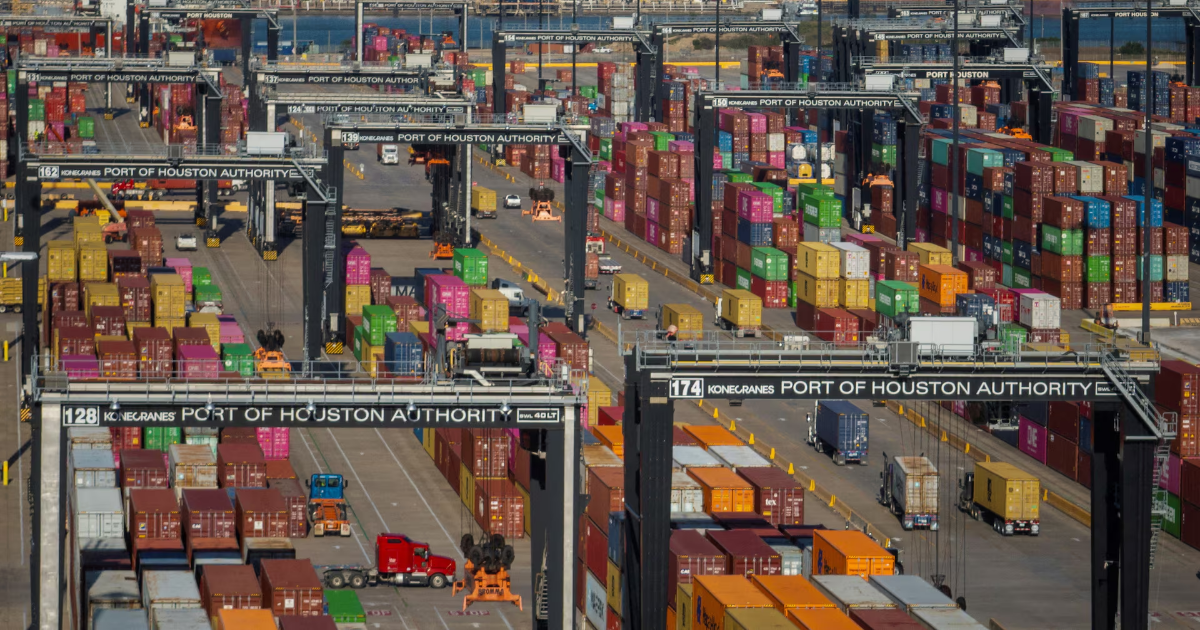WASHINGTON/BRUSSELS, April 9 (Reuters) – U.S. President Donald Trump’s “reciprocal” tariffs on dozens of countries took effect on Wednesday, including massive 104% duties on Chinese goods, as the European Union prepared retaliatory measures, escalating a global trade war
Trump‘s punishing tariffs have shaken a global trading order that has persisted for decades, raised fears of recession and wiped trillions of dollars off the market value of major firms.
Sign up here.
Since Trump unveiled his tariffs last Wednesday, the S&P 500 (.SPX)
, opens new tab has suffered its deepest loss since the benchmark’s creation in the 1950s. It is now nearing a bear market, defined as 20% below its most recent high.
U.S. Treasuries were also caught up in the market turmoil and extended heavy losses on Wednesday in a sign investors are dumping even their safest assets and the dollar, a traditional safe-haven, was weaker against other major currencies.
European shares fell and U.S. stock futures pointed to more pain ahead, following a grim session for most of Asia. Chinese stocks bucked the trend, however, as state support propped up the ailing market.
EUROPE PUSHES BACK
European Union countries are expected to approve on Wednesday the bloc’s first countermeasures against Trump’s tariffs, joining China and Canada in retaliating.
The European Commission, which coordinates EU trade policy, has proposed extra duties, mostly of 25%, on a range of U.S. imports from motorcycles, poultry, fruit, wood, and clothing to dental floss, according to a document seen by Reuters.
They are to enter force in stages – on April 15, May 16 and December 1.
The tariffs are expected to cause a bigger hit to euro zone economic growth than initially estimated by the European Central Bank, although inflation may also be lower in the short term,
four sources told Reuters.
The ECB stands ready to ensure the sound financing of the euro zone economy and financial stability, French ECB policymaker Francois Villeroy de Galhau said.
CHINA WON’T ACCEPT ‘BULLYING’
China’s top leaders also plan to meet as soon as Wednesday to hammer out measures to boost the economy and stabilise capital markets, people with knowledge of the matter said.
Trump nearly doubled duties on Chinese imports, which had been set at 54% last week, in response to counter-tariffs from Beijing, which China has vowed to fight.
“The U.S. continues to abuse tariffs to pressure China, China firmly opposes this and will never accept this kind of bullying,” Chinese Foreign Ministry spokesperson Lin Jian told a news conference.
China’s currency has faced heavy downward pressure, with the offshore yuan at record lows, due to the tariffs, but sources told Reuters the central bank has asked major state-owned banks to reduce U.S. dollar purchases and will not allow sharp yuan declines.
Central banks in New Zealand and India cut rates on Wednesday in what could presage a broader move by policymakers to try to cushion the tariff hit to their economies. The duties are another argument for cutting interest rates in Poland, central banker Ludwik Kotecki said.
Trump has shrugged off the market rout and offered investors mixed signals about whether the tariffs will remain in the long term, describing them as “permanent” but also boasting that they are pressuring other leaders to ask for negotiations.
This map shows the percentage of reciprocal tariffs imposed by the U.S. administration on each economy.
U.S. CONSUMERS
Some economists have warned that U.S. consumers are likely to bear the brunt of the trade war, facing higher prices on everything from sneakers to wine.
Nearly three-quarters of Americans expect the prices of everyday items to rise in the next six months, a new Reuters/Ipsos poll found.
Danish luxury stereo maker Bang & Olufsen (BO.CO)
, opens new tab said on Wednesday it would raise prices on selected products next month to account for the tariffs and other factors.
The full effects of Wednesday’s tariffs may not be felt for some time, as any goods already in transit as of midnight will be exempt from the new levies as long as they arrive in the U.S. by May 27.
Trump says the tariffs, which took effect at 12:01 a.m. ET (0401 GMT), are aimed at countries that are “ripping off” the U.S.
That list includes many of the United States’ closest allies, including the European Union, which was hit with a 20% tariff as well as industry-specific duties.
Trump has said his tariffs are a response to barriers put on U.S. goods and are needed to fix America’s trade imbalances. He has also signaled he may not be finished, telling Republican lawmakers he may announce duties on pharmaceutical imports.
A table showing sectors of imported products and the corresponding estimated price increases that could result from Trump’s sweeping tariffs, ranging from 10% for medical diagnostic equipment to 30% for computer parts and toys & video games.
Meanwhile, Trump’s administration is considering softening its proposed fee on China-linked ships visiting U.S. ports after a flood of negative feedback from industries, according to six sources, as the tariffs dampen appetite for U.S. products.
“As of now, most importers are not taking the risk of importing from the U.S.,” said a Singapore-based trader at an international company which sells U.S. grains and oilseeds into Asia.
Reporting by Reuters newsrooms; Writing by Joseph Ax, John Geddie, Ingrid Melander; Editing by Lincoln Feast and Sharon Singleton
Our Standards: The Thomson Reuters Trust Principles.
